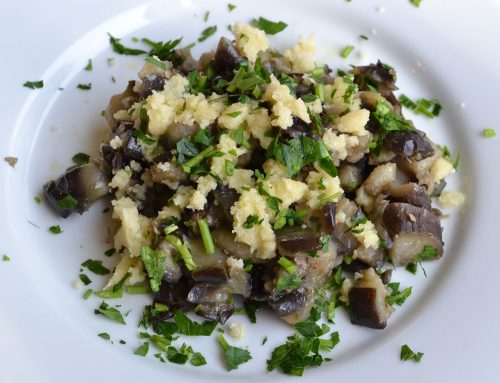
Servants slaughter sheep and prepare stew in an illustration from the 14th century Spanish haggadah known as The Golden Haggdah
The origins of the word “adafina” are not exactly known. The more accepted interpretation is that it comes from the Spanish Arabic word addafína, which derives from the Classical Arabic word dafīnah meaning ‘hidden’ or ‘buried.’ This etymology makes sense since the adafina had to cook overnight on the hearth without further intervention; it was covered in the embers or set under an iron pot filled with glowing coals and left to slow-cook until the time for the meal came on Saturday. Sephardic Jews in Morocco still prepare their adafinas or t’finas in this way.
In Spain the dish also had other names, such as trasnochado (meaning ‘cooked overnight’), and albondiguillas (‘little meatballs’). These terms could be used in other contexts, but always referred to the Sabbath meal set to slow-cook before sundown on Fridays when used in the context of Jewish living. Adafina is in the same family as other one-pot meals in Spain such as ollas, cocidos, escudellas and pucheros, and it is similar to the ajiacos and sancochos of Latin America as well. Exclusively Sephardic are the names of hamín or ani, and adafina, all of which refer to the Sabbath meal and were used in Spain before 1492.
Adafinas were as varied as the households and towns of Spain. Common ingredients were legumes such as chickpeas and fava beans (other types of beans like red or pinto would come later from the New World), vegetables and, if one’s purse permitted, some meat. In some cases, the main protein appeared in the form of eggs. Huevos haminados refer to the eggs that went into the adafina or hamín as the main protein. When slow-cooked overnight in the pot with other ingredients, the eggs take a velvety and creamy texture different from regular boiled eggs. There are several contemporary recipes of Sephardic hamín–all very good–in Rabbi Robert Sternberg’s The Sephardic Kitchen, which the author gathered mostly in Israel from Sephardic families.
Adafina also appears in the oral and written histories of contemporary Jewish communities. I found stories and anecdotes from Sephardic Jews in Morocco written in Ladino at ‘Adafina: El blog de las Kehilot de habla Haketia. One story written by Soly Anidjar concerns her grandmother in 1960 Casablanca. Her grandmother, whom they called “mama Sol,” was taken ill with a fit (“patatu” or “patatús”) after eating a particularly well-endowed adafina. When the doctor came to examine her, he admonished her about the dangers of overeating. As he was talking, he was overwhelmed by the delicious smells coming from the kitchen. He was told that he was smelling the adafina and was given a heaping plate. When the doctor waxed poetic over the delicious dish, the grandmother took the opportunity to explain that even if the Jews were to be overcome by a million fits, never in a hundred years would they stop making adafina.
Links for Further Exploration
- Sephardic Studies at the University of Washington – Explore more Sephardic history and culture through articles and digital artifacts at the Stroum Center’s Sephardic Studies Program page.
- JewishStudiesHUB – Explore our innovative blog page with fresh views on Jewish topics by UW faculty and students. You can also access video clips and view new media projects.
© Ana Gomez-Bravo, 2014
The Converso Cookbook
Further reading:
David M. Gitlitz and Linda Davidson. A Drizzle of Honey: The Lives and Recipes of Spain’s Secret Jews. New York: St. Martin’s Press, 1999.
Santa María, Ramón. “Ritos y costumbres de los hebreos españoles.” Boletín de la Real Academia de la Historia 22 (1893): 181-188.
Robert Stenberg. The Sephardic Kitchen.
Sephardic Studies
Explore Sephardic history and culture more at the Stroum Center’s Sephardic Studies Program page.
Adafina Recipe
Learn how to cook adafina.







Excelente e interesante!
This is fascinating. I sent the article to my teenage grandson. A good way to teach about the expulsion of the Jews from Spain.
This is so interesting, and the story form Casablanca is fascinating. I wonder if you could find other contemporary references to this dish?
This is great! We found a similar dish in an anonymous medieval Andalusian cookbook!
[…] into Spanish cuisine – many of Spain’s regional stews (cocidos) are a variation on adafina, probably from addafína, meaning buried or hidden, as in cooked under hot coals. Even the famous […]